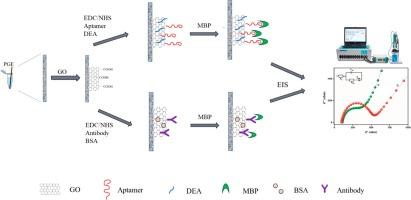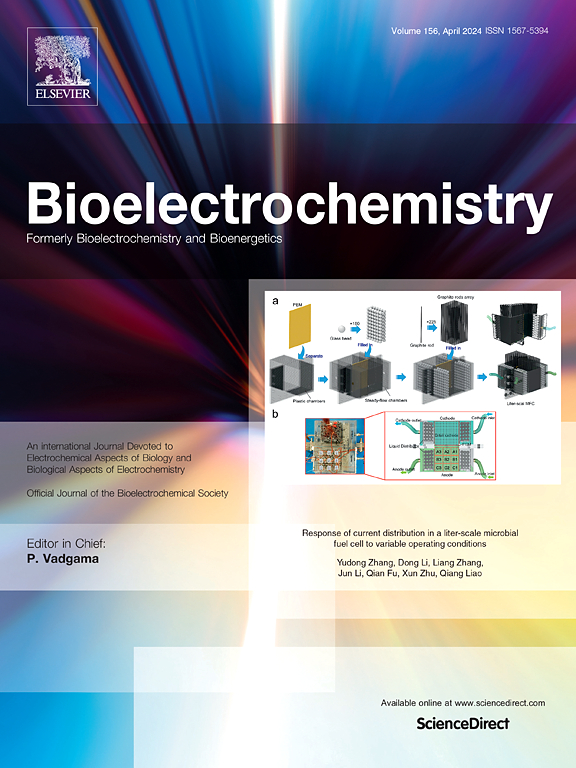Demyelination detection in CSF based on electrochemical monitoring of myelin basic protein in comparison between Apta vs. Immuno sensing strategies
IF 4.8
2区 化学
Q1 BIOCHEMISTRY & MOLECULAR BIOLOGY
引用次数: 0
Abstract
Multiple sclerosis (MS) is a recurrent inflammatory, demyelinating disease of the white matter in central nervous system (CNS). The number of MS patients is increasing, but the diagnostic process is still quite difficult, costly and requires combination of several methods. Myelin basic protein (MBP) makes up to 30 % of the myelin in CNS. It is known that MBP is released into the cerebrospinal fluid (CSF) as MS bioindicator. Herein, myelin specific DNA aptamer earlier developed for possible therapeutic purposes and anti-MBP antibody were applied as bioreceptors for MBP recognition on the same nanomodified sensor surfaces and their performances were compared. Biosensors were developed by using graphene oxide (GO) nanoparticles integrated onto pencil graphite electrodes (PGE) and bioreceptor molecules immobilized to create a bioactive layer for MBP binding. The measurements were run with electrochemical impedance spectroscopy (EIS). Selectivity of the biosensors was evaluated using human serum albumin (HSA). After optimization of binding parameters, biosensors were validated in artificial CSF. It was shown that LJM-5708 based aptasensor had LOD 0.65 ng/mL that was comparable to immunosensor LOD (0.36 ng/mL) in artificial CSF and showed its applicability in the clinical concentration range between 1 and 128 ng/mL.

基于髓鞘碱性蛋白电化学监测的脑脊液脱髓鞘检测:Apta 与免疫传感策略的比较
多发性硬化症(MS)是一种反复发作的中枢神经系统(CNS)白质脱髓鞘炎症性疾病。多发性硬化症患者的人数在不断增加,但诊断过程仍然相当困难、昂贵,需要结合多种方法。髓鞘碱性蛋白(MBP)占中枢神经系统髓鞘的 30%。众所周知,MBP 释放到脑脊液(CSF)中可作为 MS 的生物指标。在此,早先为可能的治疗目的开发的髓鞘特异性 DNA 类似物和抗 MBP 抗体被用作生物受体,在相同的纳米改性传感器表面上识别 MBP,并比较了它们的性能。开发生物传感器的方法是将氧化石墨烯(GO)纳米颗粒集成到铅笔石墨电极(PGE)上,并固定生物受体分子以形成生物活性层,从而与 MBP 结合。测量采用电化学阻抗光谱(EIS)进行。使用人血清白蛋白(HSA)对生物传感器的选择性进行了评估。优化结合参数后,在人工 CSF 中对生物传感器进行了验证。结果表明,基于 LJM-5708 的适配传感器在人工 CSF 中的 LOD 为 0.65 纳克/毫升,与免疫传感器的 LOD(0.36 纳克/毫升)相当,表明其适用于 1 至 128 纳克/毫升的临床浓度范围。
本文章由计算机程序翻译,如有差异,请以英文原文为准。
求助全文
约1分钟内获得全文
求助全文
来源期刊

Bioelectrochemistry
生物-电化学
CiteScore
9.10
自引率
6.00%
发文量
238
审稿时长
38 days
期刊介绍:
An International Journal Devoted to Electrochemical Aspects of Biology and Biological Aspects of Electrochemistry
Bioelectrochemistry is an international journal devoted to electrochemical principles in biology and biological aspects of electrochemistry. It publishes experimental and theoretical papers dealing with the electrochemical aspects of:
• Electrified interfaces (electric double layers, adsorption, electron transfer, protein electrochemistry, basic principles of biosensors, biosensor interfaces and bio-nanosensor design and construction.
• Electric and magnetic field effects (field-dependent processes, field interactions with molecules, intramolecular field effects, sensory systems for electric and magnetic fields, molecular and cellular mechanisms)
• Bioenergetics and signal transduction (energy conversion, photosynthetic and visual membranes)
• Biomembranes and model membranes (thermodynamics and mechanics, membrane transport, electroporation, fusion and insertion)
• Electrochemical applications in medicine and biotechnology (drug delivery and gene transfer to cells and tissues, iontophoresis, skin electroporation, injury and repair).
• Organization and use of arrays in-vitro and in-vivo, including as part of feedback control.
• Electrochemical interrogation of biofilms as generated by microorganisms and tissue reaction associated with medical implants.
 求助内容:
求助内容: 应助结果提醒方式:
应助结果提醒方式:


